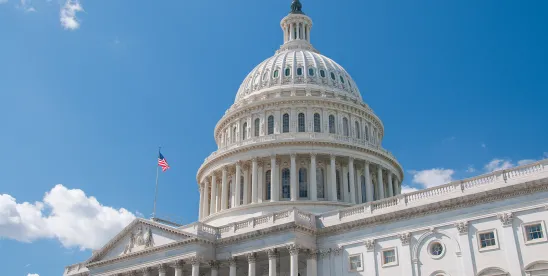On 3 July 2025, the House passed the Senate’s version of H.R. 1, the budget reconciliation bill formerly known as the “One Big Beautiful Bill Act” (the Act). President Trump signed the Act into law on 4 July 2025. The legislation changed significantly over several iterations from its initial House committee-passed version through the final Senate amendment. Such changes were necessary to generate support, as Republican leaders navigated narrow margins in both chambers and responded to a shifting international tax policy environment.
The Act includes extensions of current tax provisions and makes many significant tax changes, which Congressional budget estimators indicate will reduce federal revenues by US$4.4 trillion during the next decade. This alert describes several of the material changes included in the legislation.
General Business Tax Provisions
The Act addresses a broad range of business tax topics, including updates to provisions created by the Tax Cuts and Jobs Act of 2017 (the TCJA) that were scheduled to expire or change, or that had already changed as scheduled under the TCJA.
Bonus Depreciation
The Act permanently extends 100% bonus depreciation for qualified property acquired and placed in service after 19 January 2025 and makes available an additional first year depreciation deduction for certain manufacturing, production, and refining property acquired or constructed after 19 January 2025 and placed in service before 1 January 2030.
Research and Experimental Expenses
As a result of the TCJA, domestic research and development expenditures for tax years beginning after 31 December 2022 were required to be capitalized and amortized over five years. The Act restores the deduction for research or experimental expenditures paid or incurred after 31 December 2024 but limits this to domestic expenditures. Certain small businesses are eligible to apply this change retroactively, and other taxpayers are generally permitted to elect to deduct previously capitalized expenses over an elective one- or two-year period.
Limitations on Business Interest Expense
The TCJA updated Section 163(j) of the Code1 to limit the business interest expense deduction to the sum of business interest income, 30% of adjusted taxable income (ATI) of the taxpayer for the taxable year (not less than zero), and the floor plan financing interest of the taxpayer for the taxable year.
Initially, ATI was computed by adding back to a taxpayer’s income any deduction allowable for depreciation, amortization, or depletion deductions—making ATI broadly equivalent to EBITDA. For tax years beginning after 1 January 2022, however, Section 163(j) did not include an add-back for depreciation, amortization, or depletion deductions, making ATI broadly equivalent to EBIT. The Act restores ATI to an EBITDA-equivalent calculation by reinstating the add back of a taxpayer’s depreciation, amortization, and depletion expenses, increasing the deductible portion of interest for many taxpayers.
Disguised Sales of Property or Services
Section 707(a)(2) of the Code provides for the recharacterization of certain transactions between one or more partners and a partnership (including certain transactions to be recharacterized as “disguised sales of partnership interests”). While Section 707(a)(2) applied “under regulations prescribed by the Secretary,” the Department of the Treasury and the Internal Revenue Service (IRS) have never issued final regulations as contemplated by the Code on disguised sales of services and of partnership interests. The Act provides that section 707(a)(2) is self-executing and applies even in the absence of such regulations.
Qualified Business Income Deduction
Section 199A of the Code provides for a 20% deduction for qualified business income available to noncorporate taxpayers. As introduced by the TCJA, the deduction was scheduled to expire after 2025. The Act permanently extends it.
Excess Business Loss Limitation
The Act makes permanent the limitation on excess business losses of noncorporate taxpayers in Section 461(l) of the Code. As introduced by the TCJA, the limitation would have expired after 2028.
Qualified Small Business Stock
For “qualified small business stock” (QSBS) issued after 4 July 2025, the Act provides that:
- The gross asset value cap for QSBS issuers increases from US$50 million to US$75 million (subject to an inflation adjustment);
- The formula for the per-issuer cap on the QSBS exclusion is amended by increasing the dollar-based limit on excluded gain from US$10 million to US$15 million (also adjusted for inflation); and
- The holding period required to qualify for any QSBS benefits is shortened, providing a 50% exclusion for gain recognized if the QSBS is held for three years and a 75% exclusion for gain recognized if the QSBS is held for four years.
Gain recognized on QSBS held for five years is eligible for a 100% exclusion, similar to the pre-Act approach for QSBS issued after 27 September 2010.
Advanced Manufacturing Credit
The Act increases the Section 48D tax credit created by the Creating Helpful Incentives to Produce Semiconductors for America (CHIPS) Act from 25% to 35% for property placed in service after 31 December 2025. The original termination date of the credit, 31 December 2026, is unchanged.
International Tax Provisions
The Act makes various updates to the TCJA’s revised international tax framework. Not included in the final legislation was an earlier proposal to impose a retaliatory tax on certain taxpayers associated with foreign countries that impose “discriminatory” taxes on US taxpayers. This provision—proposed Section 899 of the Code—was dropped from the legislation following negotiations to exempt US companies from Pillar 2’s Income Inclusion Rule and the Undertaxed Profits Rule “in recognition of the existing US minimum tax rules.”
Controlled Foreign Corporation Provisions
The Act reinstates Section 958(b)(4) of the Code, which was removed by the TCJA. Section 958(b)(4) prevents downward attribution of stock from a foreign person to a US person for purposes of determining “controlled foreign corporation” (CFC) status. By removing Section 958(b)(4), the TCJA had caused many foreign corporations to become CFCs due to the Code’s “constructive” ownership rules. Instead, the Act adds a new Section 951B, creating a concept of a “foreign controlled foreign corporation” whereby “foreign controlled United States shareholders” are subject to tax on foreign subsidiary earnings in a more targeted approach than the TCJA’s repeal of Section 958(b)(4).
The Act repeals the one-month deferral election for specified foreign corporations under (former) Section 898(c)(2) of the Code.
For tax years of foreign corporations beginning after 31 December 2025, the Act modifies the inclusion rule applicable to Subpart F income of a CFC to require a “United States shareholder” of a CFC to include its pro rata share of such income if it owns stock on any day during the CFC’s taxable year, rather than all such income being included as of the last day of the CFC’s taxable year.
The Act also makes permanent the “look-through” rule of Section 954(c)(6) of the Code, which makes it more likely that passive income received by a CFC from a related person that is engaged in an active trade or business will not be considered Subpart F income.
GILTI Income
For tax years beginning after 31 December 2025, the Act renames Global Intangible Low-Taxed Income (GILTI) to “Net CFC Tested Income.” The Act removes the deduction allowed against GILTI income for qualified business asset investment (generally, based on a deemed 10% return on certain business assets) and adjusting applicable deductions and foreign tax credits to target an effective 14% tax rate on Net CFC Tested Income. The Act similarly adjusts foreign tax credits on distributions from earnings and profits previously subject to Section 951 taxes.
FDII
For tax years beginning after 31 December 2025, the Act renames Foreign-Derived Intangible Income to “Foreign-Derived Deduction Eligible Income.” Like the GILTI changes, the Act also removes the deduction allowed against Foreign-Derived Deduction Eligible Income for qualified business asset investment and provides for an effective 14% tax rate on all Foreign-Derived Deduction Eligible Income.
BEAT Rate Changes
As introduced by the TCJA, the rate of the Base Erosion and Anti-Abuse Tax (the BEAT) was 10% and scheduled to increase to 12.5% in 2026. The Act permanently sets the BEAT rate at 10.5% for tax years beginning after 31 December 2025. Notably, the Act did not include an exception for payments to high-tax foreign affiliates, which had been part of the Senate Finance Committee’s original proposal.
Energy Provisions
The Act limits or phases out many clean energy incentives and credits. Changes to this chapter of the legislation occupied lawmakers until final passage, with extensive lobbying on both sides. Ultimately, final passage of the legislation in the House was delayed as conservative members sought reassurances from the White House to further curtail support for clean energy. Certain material changes are outlined below. A proposed excise tax on clean energy facilities added midway through the legislative process was removed from the legislation following significant criticism from the clean energy community and a number of Republican senators. These changes, and other clean energy impacts of the Act, will be addressed in more detail in a future alert.
Wind and Solar Energy
The Act provides that qualifying wind and solar projects that begin construction after the date that is 12 months after enactment of the Act must be placed in service by 31 December 2027 to qualify for investment or production tax credits.
The Act also introduces new eligibility requirements for investment or production tax credits that address Chinese ownership or influence (prohibited foreign entities) over otherwise eligible projects that apply to credits claimed for taxable years beginning after 4 July 2025, and additional rules addressing Chinese supply chains for projects that begin construction in 2026 or later (material assistance cost ratio). A new 10-year recapture period is included to enforce such limitations, along with increased penalties on claimants and suppliers.
The Act also eliminates the five-year cost recovery designation for solar, wind, and energy storage property that commenced construction after 31 December 2024.
Clean Fuels
The Act extends the production tax credit for clean fuels from 31 December 2027 to 31 December 2029. It prohibits the use of negative emissions rates and eliminates the special rates for sustainable aviation fuel for fuel produced and sold after 2025.
Fuel Cell Energy Credit
The Act includes a new 30% investment tax credit for qualifying fuel cell projects that begin construction after 31 December 2025.
Hydrogen Production Credit
The Act accelerates the commencement of construction deadline for the 10-year clean hydrogen production credit enacted by the Inflation Reduction Act from 1 January 2033 to 1 January 2028.
Expansion of Permitted Publicly Traded Partnerships
For tax years beginning after 31 December 2025, qualifying income of a publicly traded partnership is expanded to include income derived from (i) qualifying hydrogen storage and transportation, (ii) electricity production from qualifying nuclear, hydropower, and geothermal facilities, (iii) carbon capture facilities, including electricity production from qualifying facilities with sufficient carbon capture, and (iv) thermal energy from hydropower and geothermal facilities.
Real Estate
Real Estate Investment Trust Asset Test
For taxable years beginning after 31 December 31 2025, the percentage of assets that real estate investment trusts are permitted to hold through “taxable REIT subsidiaries” increases from 20% to 25%.
Opportunity Zones
For investments made after 31 December 2026, the Act permanently implements the Opportunity Zone program from the TCJA, with rolling 10-year designations of qualifying census tracts. The Act permits deferral (for five years or until the investment is sold) of capital gains reinvested in an Opportunity Zone but caps the exclusion from future gains from the sale or exchange of an Opportunity Zone investment held for at least 10 years to the gain that has accrued after 30 years. The Act provides a tax basis step-up in the Opportunity Zone investment equal to 10% of the reinvested gain (30% for certain “qualified rural opportunity funds”) if the investment is held for at least five years.
The Act also adds new reporting requirements and related penalties for Opportunity Zone investments.
Other Provisions
Estate and Gift Tax Exclusion
For estates of decedents dying and gifts made after 31 December 2025, the Act permanently increases the estate and gift tax exclusion to US$15 million, adjusted for inflation.
New Floor for Deductions of Charitable Contribution
The Act imposes a new floor for deducting charitable contributions—one percent for corporate taxpayers and a 0.5% for individuals who itemize deductions.
New Excise Tax on Remittance Transfers
The Act introduces a new Section 4475 of the Code, imposing a one percent excise tax on certain remittances of money from the United States to a foreign recipient not funded from an account at certain financial institutions or funded by a debit or credit card issued in the United States. Remittance transfer providers are required to collect the tax and will bear secondary liability for it if not collected at the time a transfer is made.
Employee Retention Tax Credits
In each case for employee retention tax credit claims for Q3 and Q4 2021, the Act:
- Expands the 20% erroneous refund penalty to apply to such claims;
- Requires compliance with eligibility diligence requirements for credit promoters;
- Retroactively bars the IRS from issuing refunds for employee retention tax credit claims for Q3 and Q4 2021 that were filed after 31 January 2024; and
- Extends the statute of limitations on employee retention tax credit refunds attributable to such quarters to six years from the date of the claim.
State and Local Tax Deduction
The Act raises the US$10,000 TCJA cap on the state and local tax deductions to US$40,000 for taxable years 2025 through 2029 (with that cap increasing by one percent each year) but reverts the cap on such deductions back to US$10,000 in 2030. The Act’s temporary increase in the cap is subject to an income-based phasedown.
Endowment Tax
For taxable years beginning after 31 December 2025, the Act adds two new graduated rates to the TCJA’s 1.4% university endowment excise tax. The new rates apply based on the size of the endowment measured on a per student basis—institutions with a student-adjustment endowment of US$750,000-US$2 million are subject to a four percent excise tax and institutions with a student-adjusted endowment in excess of US$2 million are subject to an excise tax of eight percent. Institutions with fewer than 3,000 students are now exempt from the tax; this threshold is increased from the TCJA threshold of 500 students, and institutions with a student-adjusted endowment of less than US$500,000 remain exempt from the tax. The Act also expands the net investment income base of the tax and authorizes the Department of the Treasury to promulgate guidance to prevent avoidance of the tax through the restructuring or other arrangements designed to reduce or eliminate the amount of net investment income or assets subject to the tax.
Temporary Benefits for Individuals
The Act includes several temporary benefits for individuals. These include an exemption from income of up to US$25,000 on tip and overtime income, an enhanced deduction for seniors in the amount of US$6,000, and deductibility of car loan interest up to US$10,000 per year for vehicles the final assembly of which is in the United States. These benefits are subject to income limitations and are available in tax years 2025 through 2028.
Next Steps
The Act contains many substantive changes to the Code and we expect significant regulatory and subregulatory guidance from the Department of the Treasury to interpret the legislation.








 />i
/>i

